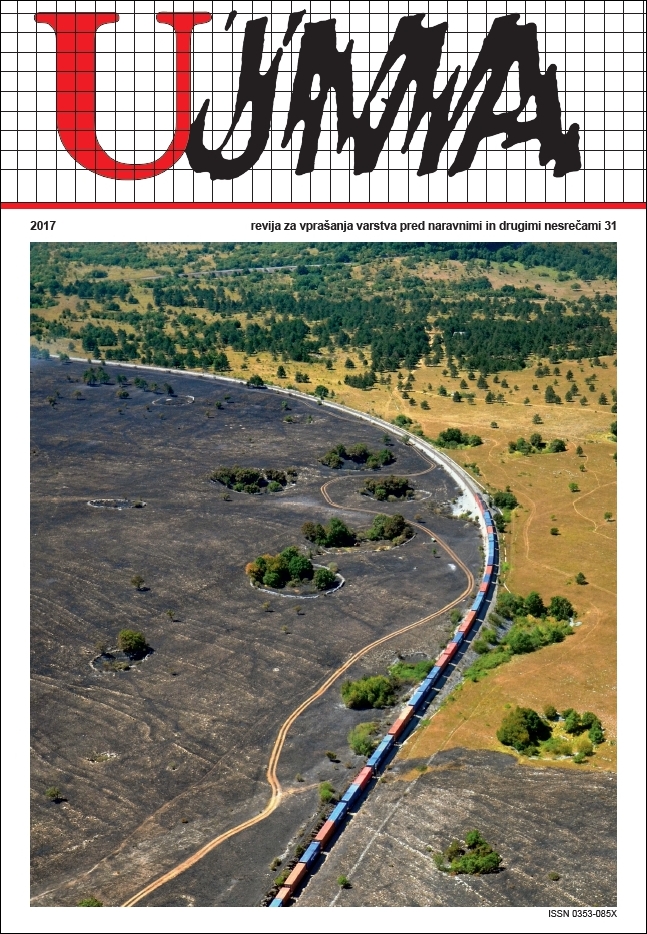THE HEAT LOAD OF SLOVENIAN WORKERS
Abstract
The rise in air temperatures and the aging of working population are expected to cause higher heat stress for European workers. In a warm environment the brain diverts more blood to the skin surface, but when there is an excess of heat, the internal systems start to fail. Heat-induced health problems are mainly caused by the loss of fluids and salts. Employers must take into account that aging decreases the effectiveness of the sweat glands, heart, and lungs. The thermal comfort of 80% of workers is considered to be a reasonable lower limit to ensure thermal comfort in the working area. Of the 808 workers in this survey, heat stress was highest for workers in factories, where 45% of them stated that during heatwaves it is extremely hot, for 20% it is too hot and for 20% hot. For this reason the highest proportion of manufacturing workers experience a negative heat stress impact on well-being (75%) and concentration (67%), but their productivity must stay at the same level due to working standards. By contrast, 17% of tourist guides assess that their working capacity is reduced by more than 30% during heat waves. Thirst, excessive sweating, and tiredness appear to be fairly common during work in summer, and also dizziness in women. During heatwaves, a large proportion of workers experience headaches, exhaustion, nausea or vomiting, and even worse health problems – heat cramps were experienced by both manufacturing and farm workers, but heat stroke only in the manufacturing sector. Following recommendations, employers should inform their employees of the risks of working in hot conditions and about first aid. They should provide the best possible thermal comfort in the workplace, more breaks in cooler areas, an adjusted working schedule, more appropriate clothing, allow for regular drinking water, and in the hottest workplaces, rotation and pair work.
References
EEA (Evropska okoljska agencija), 2010. The European environment - state and outlook 2010: synthesis. European Environment Agency, Copenhagen.
Fabijan, J., 2015. Varnostni ukrepi ob visokih temperaturah na delovnih mestih (predstavitev neuradne brošure ZZZS in ZVZD). http://www.zbornica-vzd.si/media/Varnostni%20ukrepi%20pri%20povi%C5%A1ani%20temperaturi%20v%20delovnem%20okolju%20-%20pregled_06_07_2015(1).pdf (10. 3. 2017).
HS (projekt Heat-Shield), 2016. https://www.heat-shield.eu/ (2. 2. 2017).
HSE (Zdravje in varnost delovne populacije; angl. Health and Safety Executive, ZK). http://www.hse.gov.uk/temperature/index.htm (13. 2. 2017).
IRSD (Inšpektorat RS za delo), 2015. Ukrepi delodajalca ob visokih temperaturah na delovnem mestu. http://www.id.gov.si/fileadmin/id.gov.si/pageuploads/Varnost_in_zdravje_pri_delu/VISOKE_TEMPERATURE_-_PROMOCIJA/visoke_temperature_na_dm_sj_2015.pdf (10. 4. 2017).
Kajfež Bogataj, L., Pogačar, T., Zalar, M., Črepinšek, Z., 2017. Pomen vročinskih valov v hortikulturi. V: Hudina, M. (ur.). Zbornik referatov 4. slovenskega sadjarskega kongresa z mednarodno udeležbo, Krško, 20. do 21. januar 2017. Ljubljana: Strokovno sadjarsko društvo Slovenije, 2017, 153–158.
NIJZ (Nacionalni inštitut za javno zdravje), 2016. Podnebne spremembe in zdravje v Sloveniji. http://www.nijz.si/sites/www.nijz.si/files/publikacije-datoteke/podnebne_sprememebe_in_zdravje_2016_spletissn.pdf (5. 4. 2017).
OSHA, 2015. Evropska agencija za varnost in zdravje pri delu. http://osha.europa.eu (4. 4. 2017).
Pogačar, T., Zalar, M., Kajfež Bogataj, L., 2016a. Vročinski valovi v povezavi z zdravjem in produktivnostjo. Ujma, 30, 151–160.
Pogačar, T., Zalar, M., Črepinšek, Z., Kajfež Bogataj, L., 2016b. Vročinski valovi v Sloveniji. V: Maček Jerala, M., Maček M. A., Kolenc Artiček, M. (ur.) Z znanjem in izkušnjami v nove podjetniške priložnosti: zbornik referatov, 4. konferenca z mednarodno udeležbo – konferenca VIVUS, 20. do 21. april 2016, Strahinj, Slovenija, 58–64.
WSHD (Oddelek za varnost in zdravje na delovnem mestu), 2007. Guideline for Thermal Stress, Worplace Safety and Health Division, Manitoba Labour and Immigration, Univerza v Manitobi. https://umanitoba.ca/admin/audit_services/media/Thermal_Stress_in_the_Workplace_-_Manitoba_Health_and_Safety.pdf (5. 4. 2017): 16 str.
Tomažič, G., 2016. Pogostost pojavljanja vročinskih valov v Sloveniji in njihov vpliv na kmetijstvo: diplomsko delo. Biotehniška fakulteta, Oddelek za agronomijo, Ljubljana, 86 str.
Zalar, M., Pogačar, T., Črepinšek, Z., Kajfež Bogataj, L., 2017. Vročinski valovi kot naravna nesreča v mestih. V: Zorn, M. in sod. (ur.) Trajnostni razvoj mest in naravne nesreče, (Knjižna zbirka Naravne nesreče, 4), 1. izd. Ljubljana: Založba ZRC, 2017, 41–49.
ZSSS (Zveza svobodnih sindikatov Slovenije), 2015. Kaj storiti, če je poleti vročina na delovnem mestu previsoka? http://www.sdgd.si/uploads/kaj_storiti_ce_je_na_delovnem_mestu_nad_28_stopinj.pdf (1. 2. 2017).
ZVZD (Zbornica varnosti in zdravja pri delu), 2015. Toplotno okolje na delovnem mestu (ZZZS in ZVZD): Neuradni prevod navodil za toplotno okolje na delovnem mestu HSE, Velika Britanija. http://www.zbornica-vzd.si/media/Toplotno%20ugodje-%20UK%20smernice_06_07_2015.pdf (1. 3. 2017): 36 str.
Downloads
Published
Issue
Section
License

This work is licensed under a Creative Commons Attribution-NonCommercial-NoDerivatives 4.0 International License.
The articles are made available to the public under Creative Commons Attribution-NonCommercial-NoDerivatives 4.0 International (CC BY-NC-ND 4.0).


